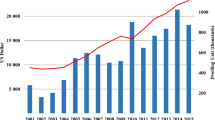Abstract
Over the last 25 years, ‘affordability’ has become a more important issue in housing policy, although it is still not fully enshrined in agreed standards, partly due to different views about how it should be measured and at what thresholds. This paper argues that subjective evidence of payment problems and material hardship can be used to validate ratio measures and points to the best thresholds to use. Using household panel survey evidence it is shown that traditional affordability ratios are still probably the best objective measure, with residual income ratios in a supporting role; and that relatively generous thresholds are better. Composites with subjective payment problems are well validated by independent evidence on material hardship, and are associated with higher incidence of moves and other housing needs. These problems are much more prevalent in private renting, with less variation between regions than household types. Multivariate models shows strong effects from income and prices interacted with interest rates, especially for owners, with significant labour market and demographic effects, and substantial effects for renters from the supply of social lettings.
Similar content being viewed by others
References
Armenoff, K. (1998). Shelter poverty: New ideas on housing affordability. Journal of Urban Affairs, 20(3), 359–362.
Atkinson, A., & Marlier, E. (2010). Income and living conditions in Europe. Luxembourg: Eurostat.
Barker, K. (2004). Review of housing supply: Delivering stability: Securing our future housing needs. Final report & recommendations. London: TSO/H M Treasury.
Bradshaw, J. (Ed.). (1993). Budget standards for the United Kingdom. Aldershot: Avebury/Ashgate.
Bramley, G. (1990). Access, affordability and housing need. Paper presented at ESRC Housing Studies Conference, University of Surrey, Sept 1990. Mimeo, SAUS: University of Bristol.
Bramley, G. (1994). An affordability crisis in British housing: dimensions, causes and policy impact. Housing Studies, 9(1), 103–124.
Bramley, G. (2006). Affordability comes of age. In P. Malpass & L. Cairncross (Eds.), Building on the Past: visions of housing futures (pp. 127–162). Bristol: Policy Press.
Bramley, G., Pawson, H., White, M., Watkins, D., & Pleace, N. (2010). Estimating housing need. Housing Research Report. Department of Communities and Local Government. London: DCLG. http://www.communities.gov.uk/publications/housing/estimatinghousingneed.
Brewer, M., o’Dea, C., Paull, G., & Sibieta, L. (2009). The living standards of families with children reporting low incomes DWP Research Report 577. London: Department of Work and Pensions. http://www.research.dwp.gov.uk/asd/asd5/rports2009-2010/rrep577.pdf.
Chaplin, R., & Freeman, A. (1999). Towards an accurate description of affordability. Urban Studies, 11, 1949–1957.
Chen, J., Hao, Q., & Stephens, M. (2010). Assessing housing affordability in post-reform China: A case study of Shanghai. Housing Studies, 25(6), 877–901.
Communities and Local Government (CLG). (2006). A decent home: Definition and guidance for implementation, department for communities and local government, June 2006. London: CLG.
Communities and Local Government (CLG). (2007). Strategic housing market assessment guidance. London: CLG.
Family Budget Unit. (2002). Summary budgets at low cost but acceptable level. University of York. http://www.york.ac.uk/res/fbu/documents/lcba_budget_aug2002.pdf.
Fahmy, E., Levitas, R., Gordon, D., & Patsios, D. (2009). Understanding the risks of social exclusion across the life course: Working age adults without dependent children. Research Report to Social Exclusion Task Force, Cabinet Office. http://www.cabinet-office.gov.uk.
Financial Services Authority (FSA). (2010). Mortgage market review: Responsible lending. Consultation Paper 10/16. London: FSA. http://www.fsa.gov.uk.
Ford, J., Burrows, R., & Nettleton, S. (2001). Homeownership in a risk society. Bristol: Policy Press.
Gordon, D., & Pantazis, C. (1997). Breadline Britain in the 1990s. Aldershot: Ashgate.
Grigsby, W., & Rosenburg, L. (1975). Urban housing policy. New York: APS Publications.
Guio, A.-C. (2010). EU 2020 poverty reduction: Concepts, figures and challenge, Conference “Countdown to Europe 2020: Towards ‘Appropriate Indicators’ to Measure Poverty Reduction in the EU”, Centre for Parliamentary studies, 29th June 2010, Bruxelles.
Hancock, K. (1993). “Can Pay? Won’t Pay?” or economic principles of “Affordability”. Urban Studies, 30(1), 127–145.
Kearns, A. (1992). Affordability of housing association tenants. Journal of Social Policy, 21(4), 523–547.
Kempson, E., McKay, S., & Willitts, M. (2004). Characteristics of families in debt and the nature of indebtedness; DWP Research Summary; http://www.dwp.gov.uk/asd/asd5/summ2003-2004/211summ.pdf.
Kutty, N. (2005). A new measure of housing affordability: Estimates and analytical results. Housing Policy Debate, 16(1), 113–142.
Linneman, P., & Megbolugbe, I. (1992). Housing affordability: Myth or reality? Urban Studies, 29(3), 369–392.
Pantazis, C., Gordon, D., & Levitas, R. (2006). Poverty and social exclusion in Britain. Bristol: Policy Press.
Stone, M. (2006a). What is housing affordability: The case for the residual income approach. Housing Policy Debate, 17(1), 151–184.
Stone, M. (2006b). A housing affordability standard for the UK. Housing Studies, 21(4), 453–476.
Thalmann, P. (1999). Identifying households which need housing assistance. Urban Studies, 36(11), 1933–1947.
Townsend, P. (1979). Poverty in the United Kingdom. Harmondsworth: Penguin.
Whitehead, C. (1991). From need to affordability: An analysis of UK housing objectives. Urban Studies, 28(6), 871–887.
Yip, N. M., & Lau, K. Y. (2002). Setting rent with reference to tenants’ affordability: Public housing rent policy in Hong Kong. Journal of Housing and the Built Environment, 17(4), 409–418.
Author information
Authors and Affiliations
Corresponding author
Rights and permissions
About this article
Cite this article
Bramley, G. Affordability, poverty and housing need: triangulating measures and standards. J Hous and the Built Environ 27, 133–151 (2012). https://doi.org/10.1007/s10901-011-9255-4
Received:
Accepted:
Published:
Issue Date:
DOI: https://doi.org/10.1007/s10901-011-9255-4




